Zimní sporty nemusí být zastrašující ani vyžadovat pokročilé atletické dovednosti. S moderním, pro začátečníky přátelským vybavením si můžete užít sněhové aktivity bez strmé učební křivky. Zde je rychlý průvodce snadnými možnostmi a vybavením, které je zpřístupňuje:
- Snowshoeing: Tak jednoduché jako chůze, ideální na stezky nebo zahrady.
- Snowfeet Skiskates: Mini lyžařské Skiskates (17 palců dlouhé), které kombinují lyžování a bruslení, snadné na naučení a fungují s běžnými zimními botami.
- Snowfeet Skiblades: Krátké lyže (26–47 palců) nabízející stabilitu a kontrolu na sjezdovkách a stezkách.
- Assled Wearable Snow Sled: Lehký bob, který si připnete na nohy pro sjíždění kopců.
Proč si vybrat krátké lyže a Skiskates?
- Snadnější ovládání a lehčí než tradiční lyže.
- Fungují s běžnou zimní obuví – není potřeba těžkých lyžařských bot.
- Přenosné a všestranné – používejte je na sjezdovkách, stezkách nebo dokonce na své zahradě.
Cenové rozpětí:
- Snowfeet Skiskates: Od 390 $
- Snowfeet Skiblades: Od 490 $
- Assled Sled: $140
Rychlá srovnávací tabulka
| Vlastnost | Snowfeet Skiskates | Snowfeet Skiblades (99 cm) | Tradiční lyže (Rossignol/Atomic) | Assled Sled |
|---|---|---|---|---|
| Délka | 17 palců | 39 palců | 59–75 palců | Není k dispozici |
| Hmotnost | Lehké | Lehké | Těžké | Lehké |
| Obuv | Běžné boty | Běžné/lyžařské boty | Specializované lyžařské boty | Běžné boty |
| Přenosnost | Vhodné do batohu | Snadné na přenášení | Vyžaduje střešní nosič/lyžařskou tašku | Kompaktní skládání |
| Křivka učení | Snadné | Velmi snadné | Středně těžké až těžké | Velmi snadné |
| Cenové rozpětí | Od $390 | Od $490 | $400–$1,000+ | $140 |
Pokud jste v zimních sportech nováčkem, tyto možnosti vám usnadní, zpříjemní a zlevní začátek. Ať už jste na svahu, stezce nebo na své zahradě, je tu něco pro každého.
4 SNADNÉ TIPY | Jak lyžovat jako dospělý
Proč jsou krátké sněžné lyže a Skiskates nejlepší pro začátečníky
Myšlenka krátkých lyží je jednoduchá: kratší lyže jsou lehčí a lehčí lyže se snadněji ovládají. Zatímco značky jako Rossignol a Atomic se zaměřují na delší lyže, krátké lyže obvykle dosahují délky kolem 47 palců (120 cm). Skiskates jsou naopak ještě kompaktnější, obvykle měří jen 17 palců (44 cm). Tato menší velikost je činí neuvěřitelně snadno ovladatelnými, vyžadují méně úsilí při zatáčení a zároveň udržují váš těžiště stabilní.
"Ve srovnání s dlouhými lyžemi jsou krátké lyže jednodušší ve všech ohledech: na nohou působí lehčeji, snadno se přenášejí a snáze se ovládají." – Tým Snowfeet
Krátké lyže jsou ideální pro rychlé, ostré zatáčky, což znamená, že si můžete sjezdovky užívat hned. Tyto výhody vysvětlují, proč jsou produkty Snowfeet* průlomové pro začátečníky.
Výhody produktů Snowfeet* oproti tradičním lyžím a snowboardům
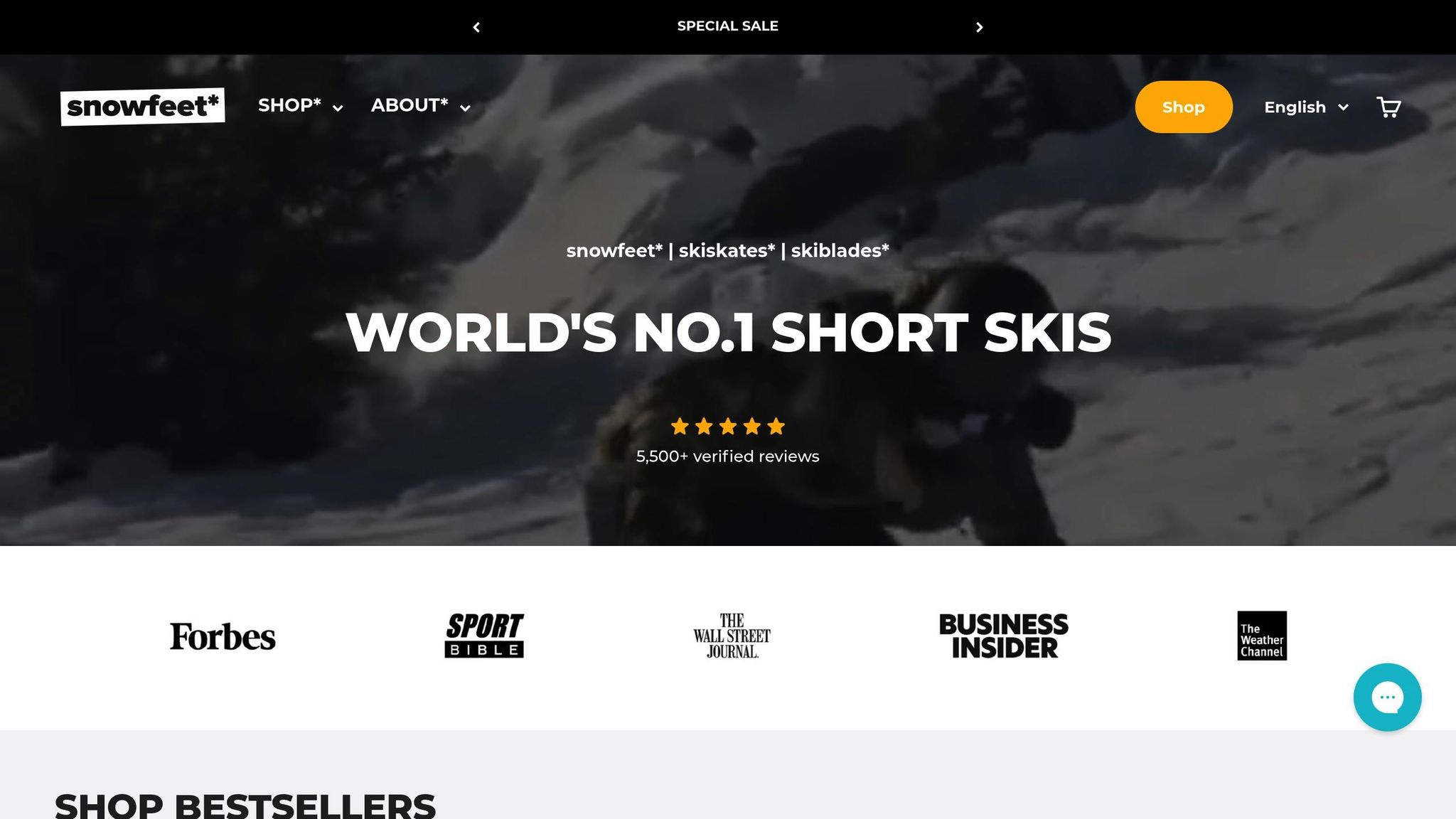
Produkty Snowfeet* přinášejí svěží přístup ve srovnání s tradičním lyžařským vybavením od značek jako Head, Elan nebo Atomic. Na rozdíl od objemného vybavení, které vyžaduje těžké boty a složitá vázání, Snowfeet* drží věci jednoduché a lehké.
Jedna velká výhoda? Nepotřebujete speciální lyžařské boty. Snowfeet* lze používat s běžnými zimními botami, pokud poskytují dobrou oporu kotníku. To nejen šetří peníze, ale také je činí velmi přenosnými – pár 17palcových (44 cm) skiskates snadno vložíte do batohu.
Rozdíl je znatelný hned. Vezměte si například Courtney Luckadoo. Poprvé zkusila lyžování ve 35 letech a během prvního dne zvládla zelenou sjezdovku za pouhé dvě hodiny – výkon, který by s tradičními dlouhými lyžemi byl mnohem těžší. Navíc, zatímco značky jako Rossignol navrhují své lyže hlavně pro upravené svahy, vybavení Snowfeet* je dostatečně všestranné, aby zvládlo různé terény. Ať už jsou to lyžařské svahy, turistické stezky nebo dokonce vaše zahrada, Snowfeet* se snadno přizpůsobí.
Tato všestrannost a pohodlí dělají ze Snowfeet* vynikající volbu pro zpřístupnění zimních sportů.
Jak vybavení Snowfeet* zpřístupňuje zimní sporty
Snowfeet* řeší tři velké překážky, které často brání lidem vyzkoušet zimní sporty: vysoké náklady, složité vybavení a faktor zastrašování.
Tradiční lyžování může být drahé, s specializovaným vybavením a skipasy, které rychle přibývají. Ale se Snowfeet* můžete hodně těchto nákladů přeskočit tím, že použijete své stávající zimní boty. Design je také osvěžující jednoduchý – není třeba se zabývat složitými vázáními nebo dalšími holemi. Mnoho modelů Snowfeet* má nastavitelné vázání, které funguje s běžnou obuví, a některé modely dokonce hole nepotřebují. Toto zjednodušené nastavení usnadňuje začátek a odstraňuje stres, který může přijít s učením něčeho nového.
"Snowfeet se velmi snadno učí hokejistům, kolečkovým bruslařům a ledním bruslařům, protože kombinují lyžování a bruslení. Nicméně, každý se je může naučit používat. Jako u každého nového sportu to zabere nějaký čas a úsilí, ale křivka učení je opravdu rychlá a užijete si to, protože Snowfeet jsou neskutečná zábava." - Tým Snowfeet
Pokud hledáte trochu větší stabilitu, delší skiblades (přibližně 39–47 palců nebo 99–120 cm) nabízejí skvělý kompromis. Poskytují extra podporu bez objemu tradičních lyží, což je další fantastická volba pro začátečníky.
Snadné zimní sporty k vyzkoušení
Hledáte zimní sporty, které se snadno naučíte a jsou plné zábavy? Tady jsou skvělé možnosti, které vás rychle dostanou do klouzání, skluzu a úsměvu. Navíc Snowfeet* nabízí vybavení přizpůsobené začátečníkům, což ještě více usnadňuje ponoření se do zasněžené akce.
Snowfeet* Skiskates: Mini lyžařské brusle pro sníh
S délkou pouhých 17 palců (44 cm) jsou Snowfeet* Skiskates jako brusle na sníh. Jsou kompaktní, přenosné a perfektní pro každého, kdo miluje myšlenku bruslení na zasněženém terénu. Pokud jste už někdy bruslili na ledě nebo na kolečkových bruslích, budete se cítit jako doma.
Co je na nich výjimečné? Jejich přenosnost. Hodíte je do batohu a jste připraveni na zasněžené dobrodružství. Nepotřebujete ani speciální boty - jsou navrženy tak, aby fungovaly s vaším běžným zimním obutím. Učení je také rychlé díky jejich přirozené kombinaci lyžování a bruslení.
Jak vysvětluje zakladatel Snowfeet* Zbyněk:
"Podle mého názoru jsou Skiskates nejlepší produkt pro sjezdovky, který jsme zatím vyvinuli. Miluji, jak snadno se na nich lyžuje a bruslí a kolik různých triků mohu provádět bez velké námahy a téměř bez omezení."
Skiskates jsou neuvěřitelně všestranné. Používejte je na sjezdovkách, v snowparcích, na turistických stezkách nebo dokonce na své zahradě. Cena začíná na 390 USD a nabízejí zábavný a flexibilní způsob, jak si užít zimu. Začátečníci by měli zůstat na upraveném sněhu a vyhnout se strmým svahům nebo hlubokému prašanu, dokud nebudou jistější. A nezapomeňte si doma nastavit vázání pro pevné a bezpečné uchycení před vyjetím.
Snowfeet* Skiblades: Krátké lyže pro různé terény
Pokud hledáte větší stabilitu, ale stále něco snadněji ovladatelného než tradiční lyže, Skiblades jsou fantastickou volbou. Jsou k dispozici ve třech délkách - 26 palců (65 cm), 39 palců (99 cm) a 47 palců (120 cm) - aby vyhovovaly různým úrovním dovedností a terénům.
Pro většinu začátečníků jsou 99cm Skiblades ideální volbou. Jsou snadno ovladatelné, ale dostatečně stabilní pro carving a all-mountain lyžování. Verze 65 cm je skvělá pro freestyle triky, zatímco 120cm Skiblades nabízejí tradičnější pocit lyžování a přitom zůstávají lehké a snadno ovladatelné.
"Pro zpomalení jednoduše nasměrujte špičky svých Skiblades dovnitř a zatlačte na hrany. Tento jednoduchý manévr se s kratšími lyžemi zvládá mnohem snadněji."
"Assled Nositelné sněžné sáňky: Jednoduché klouzání"
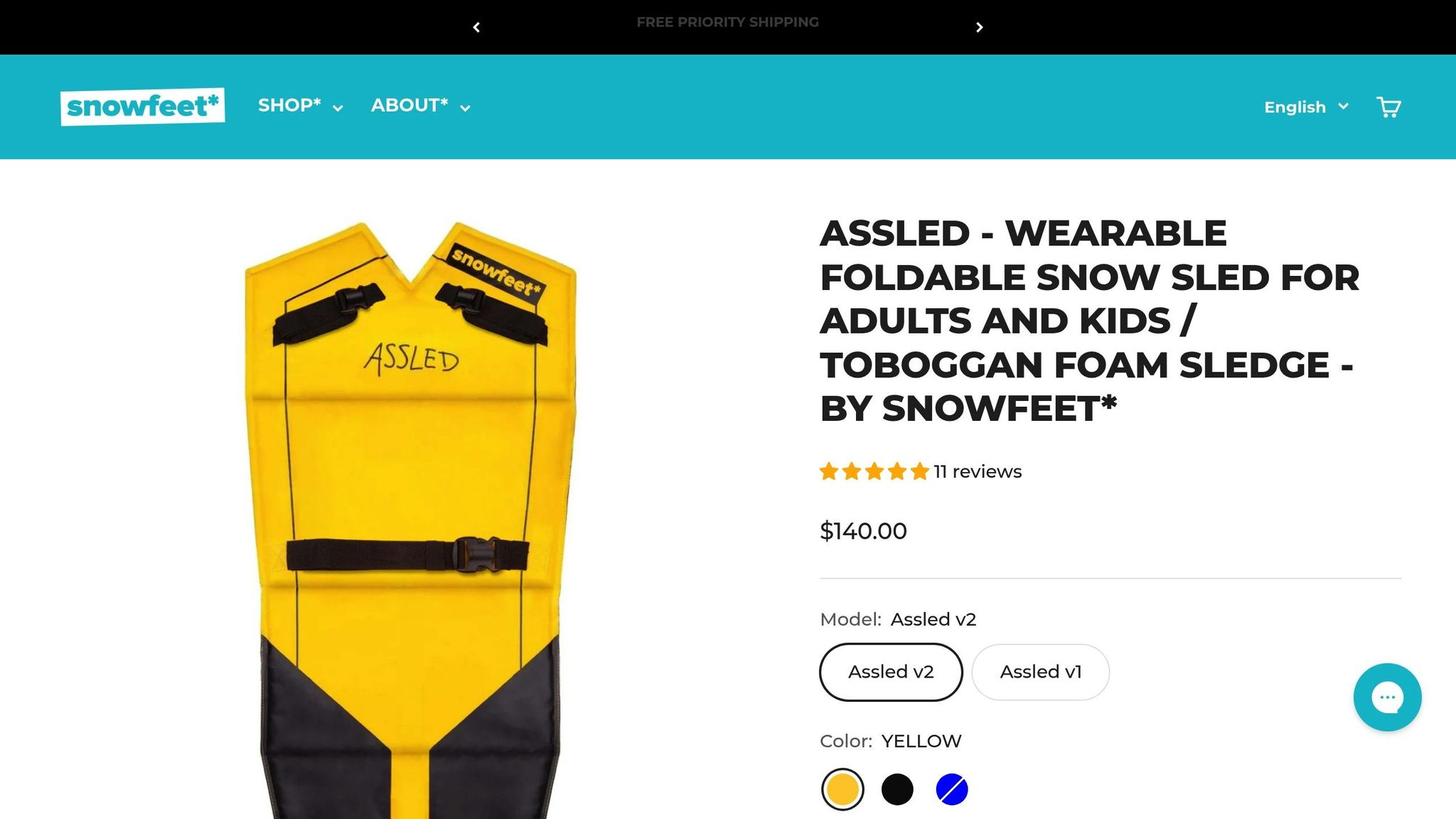
"Pokud hledáte něco nenáročného, ale přesto vzrušujícího, nositelný sněžný sáňkař Assled je zábavný způsob, jak bez použití rukou sjíždět zasněžené kopce. Je lehký, přenosný a ideální pro všechny věkové kategorie."
"Po rozložení měří Assled 86 x 41 x 2 cm, ale složí se na pouhých 24 x 41 x 8 cm a váží jen 1,3 kg. Díky tomu je velmi snadné ho nosit."
"Pro použití si ho připoutejte k nohám předními popruhy a upevněte pás kolem pasu. Stehenní popruhy se nastavují až do délky 90 cm a pás kolem pasu až do 120 cm, takže vyhovuje široké škále velikostí těla. Je vhodný pro věk od 5 do 105 let, což z něj dělá skvělou rodinnou aktivitu."
"Můžete jezdit v různých pozicích – vsedě, na zádech nebo břiše, nebo dokonce na kolenou. Zastavování a zatáčení se provádí patami a polstrovaná podložka zajišťuje pohodlí. Rukojeti vám dávají lepší kontrolu a aerodynamický design umožňuje dosáhnout působivé rychlosti. Ať už jste na sáňkařském kopci, turistické stezce nebo na své zahradě, Assled přináší spoustu zábavy za pouhých 140 dolarů."
"Jeden recenzent poznamenal, že může být "příliš kluzké na zastavení na strmých svazích", takže je nejlepší držet se mírnějších kopců, když začínáte. Jiný recenzent zmínil kombinaci s Skiskates nebo Skiblades pro plnohodnotný zimní sportovní zážitek."
sbb-itb-17ade95
"Srovnání: Snowfeet* vs Tradiční lyžařské značky"
"Pokud jste v lyžování nováček nebo nejste příliš sportovně založení, rozdíly mezi produkty Snowfeet* a tradičním lyžařským vybavením od značek jako Rossignol, Atomic, Head a Elan jsou těžko přehlédnutelné. Tradiční lyže jsou obvykle dlouhé 150–190 cm, což může být pro začátečníky ohromující. Naproti tomu vybavení Snowfeet* je mnohem kratší, od 44 cm do 99 cm. Tato kompaktní velikost usnadňuje manipulaci a je mnohem přenosnější."
"Jednou z výrazných výhod Snowfeet* je jeho praktičnost. Tradiční lyže často vyžadují střešní nosiče nebo velké lyžařské tašky pro přepravu, což přidává na nepohodlí. Vybavení Snowfeet* se naopak pohodlně vejde do batohu, což usnadňuje nošení."
"Dostatečně dlouhé na lyžování, dostatečně krátké na skating. Snadné na naučení a použití."
"Bezpečnost je další oblast, kde Snowfeet* vyniká. Na rozdíl od tradičních lyží, které jsou navrženy pro vysokorychlostní výkon a nesou riziko vážnějších pádů, je vybavení Snowfeet* navrženo tak, aby minimalizovalo dopad pádů."
"Pády jsou obecně mnohem bezpečnější než pády na lyžích nebo snowboardu."
Tradiční lyže mají také strmější křivku učení, což může být pro začátečníky odrazující. Produkty Snowfeet* jsou však navrženy pro rychlé a snadné učení. Pak je tu faktor ceny. Základní začátečnická výbava od značek jako Rossignol nebo Atomic může začínat na 400–500 USD, přičemž špičkové vybavení často přesahuje 1 000 USD. Snowfeet* nabízí cenově dostupnější alternativu, s cenami začínajícími na 150 USD a sahajícími až do 599 USD.
Srovnávací tabulka: Snowfeet* vs tradiční lyže
Zde je rychlý přehled, jak si Snowfeet* stojí ve srovnání s tradičními lyžemi:
| Vlastnost | Snowfeet* Skiskates | Snowfeet* Skiblades (99 cm) | Tradiční lyže (Rossignol/Atomic/Head) |
|---|---|---|---|
| Délka | 17 palců (44 cm) | 39 palců (99 cm) | 59–75 palců (150–190 cm) |
| Hmotnost | Lehké | Lehké | Těžké |
| Požadovaná obuv | Běžné zimní boty | Běžné zimní/lyžařské boty | Specializované lyžařské boty |
| Přenosnost | Vejde se do batohu | Snadné na přenášení | Vyžaduje střešní nosič/lyžařskou tašku |
| Křivka učení | Snadné | Velmi snadné | Středně těžké až těžké |
| Cenové rozpětí | Od $390 | Od $490 | $400–$1,000+ |
| Použití terénu | Svahy, stezky, zahrady | Všestrannost pro všechny hory | Převážně lyžařská střediska |
| Obratnost | Extrémně vysoká | Vysoká | Omezené pro začátečníky |
Produkty Snowfeet* nejsou omezeny jen na tradiční lyžařská střediska. Zatímco značky jako Atomic a Rossignol se zaměřují na výkon na upravených svazích, Snowfeet* otevírá zcela nový svět možností. Můžete je používat na běžeckých tratích, turistických stezkách nebo dokonce na své zahradě, což zimní sporty činí dostupnějšími a cenově přijatelnějšími.
Krátké lyže poskytují více zábavy a svobody pohybu, jsou hravé, citlivé, lehké na nohou, snazší na zastavení a pro mnoho lyžařů snazší na jízdu oproti těžkopádným dlouhým lyžím.
Tipy, jak začít se zimními sporty
Ponořit se do zimních sportů může být skvělá zábava, když máte správné vybavení a znalosti. Několik chytrých rozhodnutí na začátku vám zajistí bezpečný a zábavný zážitek. Zde je přehled, jak vybrat správné vybavení, obléct se podle počasí a najít ideální místa pro začátečnický trénink.
Jak vybrat správný model Snowfeet*
Zařízení Snowfeet* zpřístupňují zimní sporty a dělají je zábavnými, ale klíčem je vybrat správný model. Začněte tím, že zvážíte svou úroveň dovedností a terén, který budete objevovat. Kratší modely (pod 39 palců/100 cm) se snadněji ovládají a jsou skvělé pro začátečníky. Pokud jste úplný nováček ve zimních sportech, podívejte se na *Snowfeet Mini Ski Skates (38 cm)* - za cenu 150 USD jsou přátelské k začátečníkům a fungují s běžnou zimní obuví.
Pokud jste připraveni vyrazit na sjezdovky, *Snowfeet Skiskates (44 cm)* nabízejí větší stabilitu a zároveň jsou snadno ovladatelné. Jsou navrženy pro podmínky lyžařských středisek, začínají na 390 USD a mají odolné dřevěné jádro. Pro tradičnější lyžařský zážitek bez zbytečné hmotnosti vyzkoušejte *Snowfeet Skiblades (99 cm)*, začínající na 490 USD. Mějte na paměti, že faktory jako citlivost, rychlost a vaše výška a váha ovlivní váš výběr. Například kratší modely jsou vhodné pro menší jezdce, zatímco vyšší lidé mohou preferovat delší skiblades.
Další tip: hledejte modely s uvolňovacími vázáními, která se při pádu odpojí. Tato funkce je nejen bezpečnější, ale některá lyžařská střediska ji vyžadují, proto si před odjezdem zkontrolujte jejich pravidla pro vázání.
Základní zimní výbava pro začátečníky
Jakmile si vyberete své Snowfeet*, je čas se správně vybavit. Více vrstev je tajemstvím, jak zůstat v teple a pohodlí. Začněte s funkční spodní vrstvou z syntetických materiálů nebo merino vlny (vyhněte se bavlně - ta zadržuje vlhkost). Přidejte střední vrstvu, jako je fleecová nebo zateplená bunda, pro teplo, a navrch nepromokavou vrstvu, která ochrání před sněhem a větrem.
Bezpečnost je nezbytná. Přilba, brýle a rukavice nebo palčáky by měly být vždy součástí vaší výbavy. Tyto prvky vás nejen chrání při pádech, ale také udržují v teple. Další užitečné doplňky zahrnují nákrčník nebo kuklu a lyžařské ponožky (vlna nebo syntetika) proti puchýřům. A nezapomeňte na opalovací krém a balzám na rty s SPF - sníh odráží UV paprsky, takže spálení od slunce je reálné i v zimě.
Kde začít s zimními sporty jako začátečník
Jednou z nejlepších věcí na Snowfeet* je jejich všestrannost - fungují na sjezdovkách, turistických stezkách, snowparcích nebo dokonce na vaší zahradě. Pokud právě začínáte, trénink na známém místě, jako je vaše zahrada nebo místní park s mírnými kopci, vám pomůže získat jistotu bez stresu z pohybu v přeplněném lyžařském středisku. Jejich kompaktní velikost je činí snadno přenosnými, takže můžete objevovat blízké sáňkařské kopce nebo otevřené zasněžené plochy.
Když budete připraveni na větší dobrodružství, hledejte lyžařská střediska s přívětivými prvky pro začátečníky. Střediska s oblastmi magic carpet nebo Olympic Learning jsou ideální, protože používají dopravní pásy místo sedačkových lanovek, což usnadňuje nováčkům trénink. Vyberte místa s vyhrazenými oblastmi pro začátečníky nebo lyžařskými školami, které oddělují učební zóny od strmějších svahů. Běžkařské tratě jsou další skvělou volbou - obvykle jsou upravené a nabízejí klidný způsob, jak trénovat vlastním tempem.
Místní parky s mírnými svahy jsou také skvělé pro začátečníky. Často nabízejí užitečné vybavení jako parkoviště, toalety a vyhřívané chatky, což dělá váš první zážitek ze zimních sportů pohodlným a příjemným.
Závěr: Udělejte zimní sporty zábavnými a přístupnými
Zimní sporty nemusí být ohromující ani vyžadovat roky praxe. S produkty Snowfeet* se sjíždění svahů stává jednoduchým a zábavným - bez ohledu na vaši sportovní minulost. Ve skutečnosti si Snowfeet* již získal více než 50 000 jezdců a drží impozantní hodnocení 4,9 z 5 hvězdiček na základě více než 5 500 ověřených recenzí. Odstraněním strmé učební křivky a spoluprací s vaším běžným zimním obutím Snowfeet* eliminuje potřebu intenzivního tréninku, který tradiční lyžařské vybavení často vyžaduje.
Tato jednoduchost přináší přirozeně zcela novou úroveň všestrannosti. Výbava Snowfeet* není vázána na drahé sjezdovky - je dostatečně kompaktní, aby se vešla do batohu, a funguje stejně dobře na místních kopcích, stezkách nebo dokonce v areálech. Tato flexibilita znamená, že můžete trénovat na známém místě blízko domova, než se pustíte do náročnějšího terénu.
Navrženo pro všechny od dětí od 5 let až po dospělé do 105 let, Snowfeet* nabízí možnosti pro každého jezdce. Ať už hledáte Mini Ski Skates za 150 $ pro příležitostnou zábavu, nebo 99 cm Skiblades za 490 $ pro pokročilejší dobrodružství, vybíráte si výbavu, která se zaměřuje na to, aby zimní sporty byly příjemné a dostupné.
Nadšené recenze uživatelů mluví za vše. Vanessa z Velké Británie sdílela: "Jednoznačně jeden z nejlepších nákupů, které jsem kdy udělala." Andrew B. přidal: "Nikdy se nevrátím k původním lyžím." Tyto příběhy ukazují, jak Snowfeet* dělá zimní sporty přístupné, zábavné a okamžitě uspokojující.
Často kladené otázky
Proč jsou produkty Snowfeet snazší na použití a přenášení ve srovnání s tradičními lyžemi?
Produkty Snowfeet, jako jsou Skiskates a skiblades, jsou navrženy s ohledem na začátečníky a jsou mnohem přenosnější než tradiční lyže. S délkami od 17 do 47 palců jsou dost malé na to, aby se vešly do batohu. Perfektní pro spontánní zimní výlety! Porovnejte to s tradičními lyžemi, které často přesahují 5 stop a vyžadují objemné nosiče nebo speciální vybavení jen pro přepravu. Snowfeet usnadňuje vynechat logistiku a hned se vrhnout do zábavy.
Další velké plus? Můžete je používat s běžnou zimní obuví – není třeba utrácet za tvrdé a drahé lyžařské boty. Jejich lehký design nejen usnadňuje ovládání, ale také zkracuje křivku učení, zejména pro nováčky na svazích. Na rozdíl od tradičních lyží, které mohou být těžké a trochu zastrašující, produkty Snowfeet nabízejí přístupnější a lehčí způsob, jak si užít sníh.
Jak vybrat nejlepší model Snowfeet jako začátečník?
Výběr prvního páru Snowfeet je snadný, když víte, na co se zaměřit. Krátké modely, jako Snowfeet Mini Ski Skates (15 palců), jsou skvělou volbou pro začátečníky. Snadněji se ovládají a jsou mnohem přenosnější než běžné lyže. Pokud chcete trochu více stability, podívejte se na Skiblades (26–39 palců). Nabízejí pěknou kombinaci podpory a obratnosti, což je skvělý kompromis.
Jednou z nejlepších věcí na Snowfeet je jejich kompatibilita s běžnou zimní obuví. Nemusíte utrácet za drahé lyžařské boty! To je dělá dostupnou a bezproblémovou volbou pro každého, kdo začíná. Navíc jsou super lehké – můžete je hodit do batohu a vzít kamkoli.
Co je ještě lepší? Vybavení Snowfeet je navrženo s ohledem na začátečníky. Křivka učení je minimální, takže budete po pár hodinách svištět po sněhu. Pro každého, kdo zkouší zimní sporty poprvé, Snowfeet nabízí snadný, zábavný a nezapomenutelný zážitek!
Mohu používat produkty Snowfeet na jakýkoli typ sněhu, nebo jsou vhodnější pro specifické podmínky?
Produkty Snowfeet jsou zábavnou a přizpůsobivou volbou pro různé sněhové terény. Skvěle fungují na upravených sjezdovkách, snowparcích a zpevněných trasách. Díky kompaktní velikosti se snadno ovládají, což je ideální pro začátečníky nebo kohokoli, kdo hledá zimní aktivitu bez starostí. Jejich lehká konstrukce a krátká délka opravdu vynikají na upraveném nebo zpevněném sněhu a nabízejí hladkou a příjemnou jízdu.
To znamená, že Snowfeet nejsou nejlepší volbou pro hluboký prašan nebo velmi strmé svahy – zde vedou tradiční lyže od značek jako Rossignol nebo Atomic. Ale pro většinu rekreačních milovníků sněhu představují Snowfeet čerstvý a vzrušující způsob, jak si užít přírodu bez objemu a složitosti tradičních lyží nebo snowboardů.
Související blogové příspěvky
- Lze skutečně bruslit na sněhu? Ano! Tady je vybavení, které to umožňuje
- Nejjednodušší zimní sport? Nejlepší výběr sněžného vybavení pro okamžitou zábavu (bez nutnosti zkušeností!)
- Jak si užít lyžařský výlet, i když neumíte lyžovat nebo snowboardovat?
- Existují lyžařské alternativy, které jsou šetrnější k kolenům? (Možnosti pro rok 2025)





















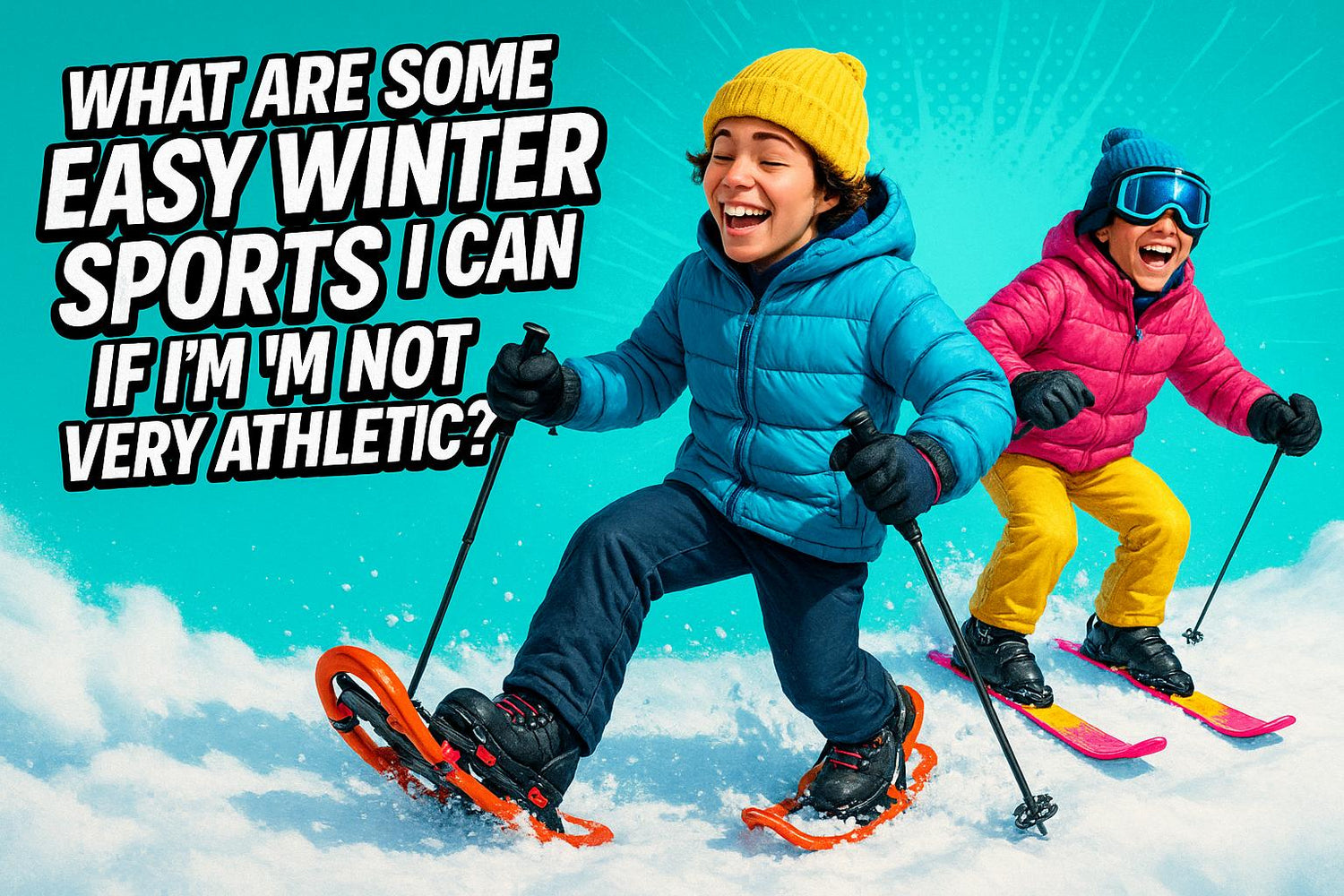
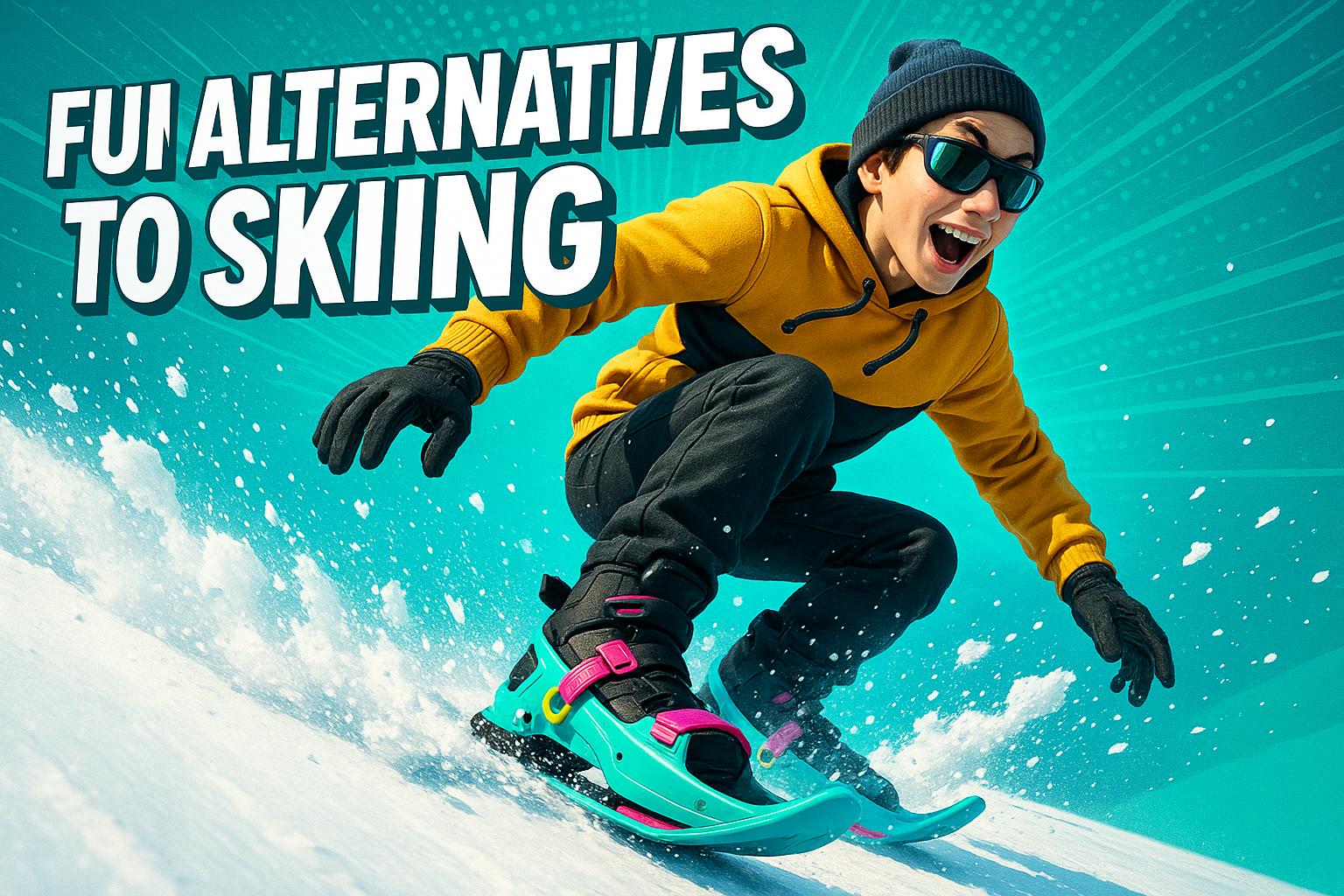
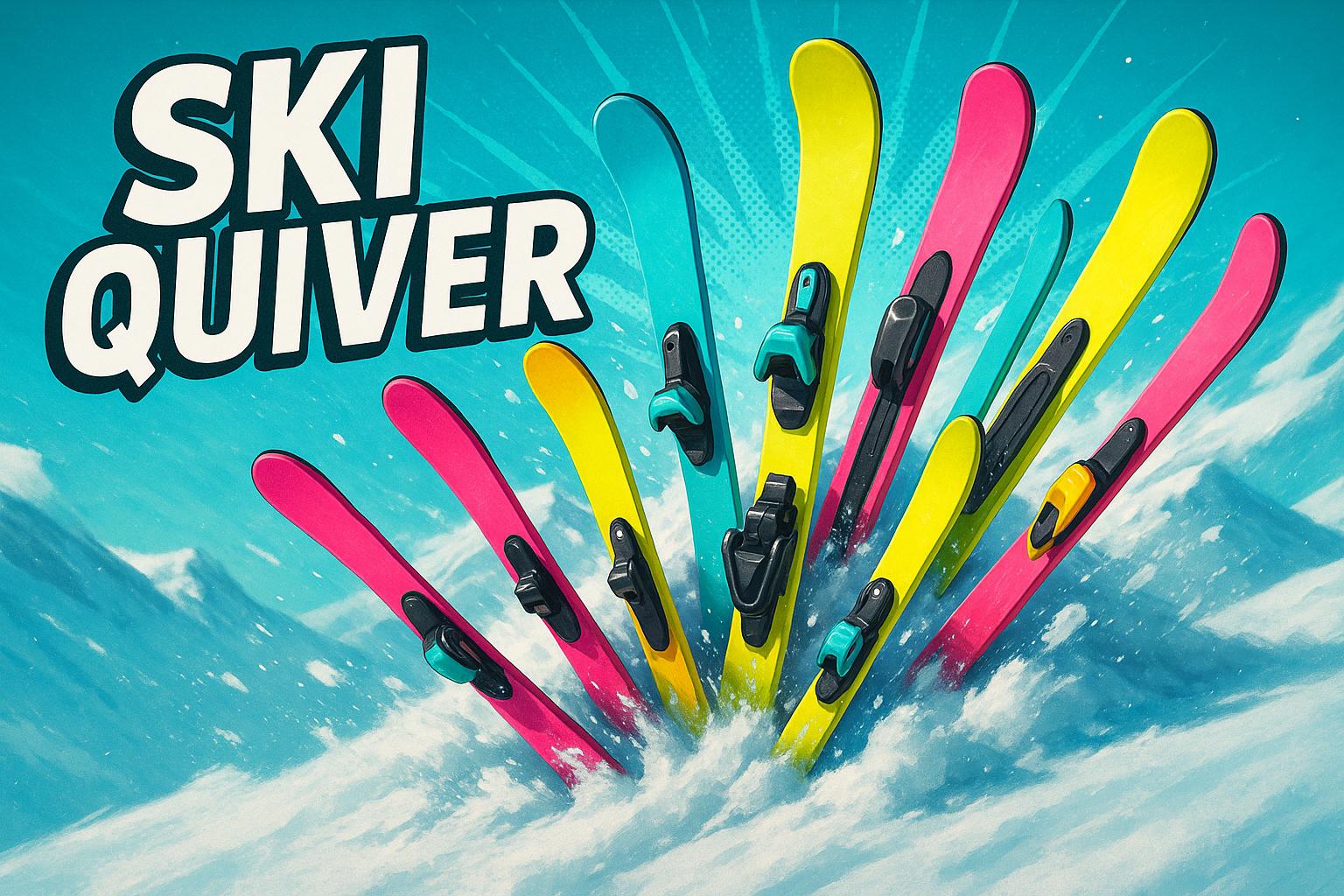










Zanechte komentář
Tento web je chráněn službou hCaptcha a vztahují se na něj Zásady ochrany osobních údajů a Podmínky služby společnosti hCaptcha.